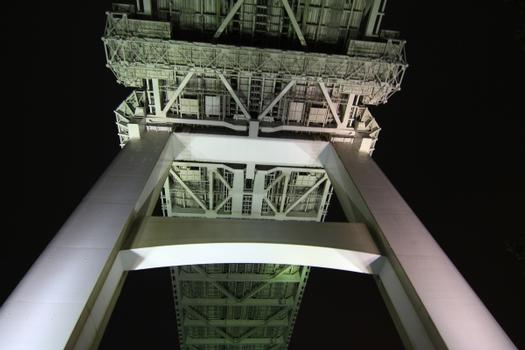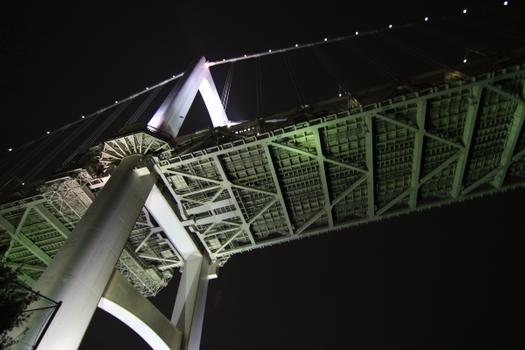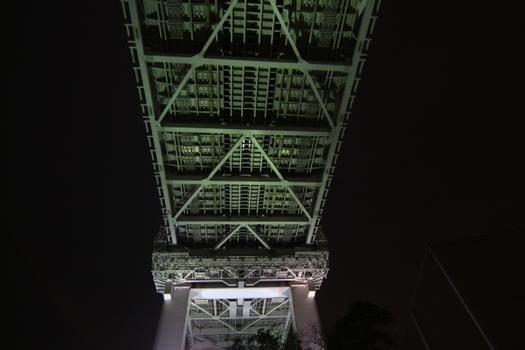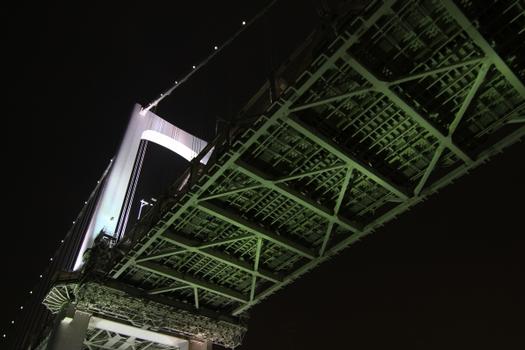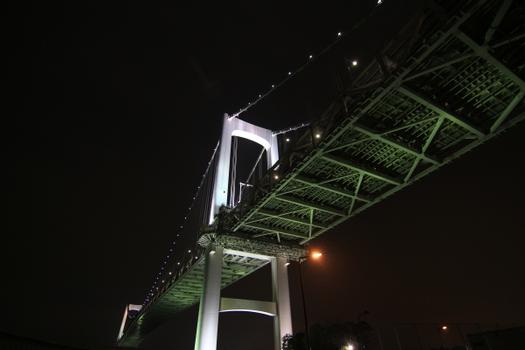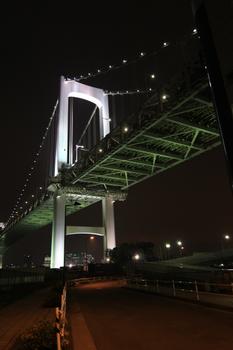General Information
| Name in local language: | レインボーブリッジ (Reinbō Buridji) |
|---|---|
| Beginning of works: | 1987 |
| Completion: | 26 August 1993 |
| Status: | in use |
Project Type
| Structure: |
Three-span suspension bridge |
|---|---|
| Material: |
Steel bridge |
| Support conditions: |
for registered users |
| Material: |
Structurae Plus/Pro - Subscribe Now! |
| Secondary structure(s): |
Structurae Plus/Pro - Subscribe Now! |
| Function / usage: |
upper deck: Motorway bridge / freeway bridge lower deck: Tramway, light or metro rail bridge |
Location
| Location: |
Minato, Tokyo, Tokyo, Japan Ariake, Koto, Tokyo, Tokyo, Japan |
|---|---|
| Crosses: |
|
| Coordinates: | 35° 38' 11.44" N 139° 45' 47.34" E |
Technical Information
Dimensions
| total length | 3.75 km | |
| main bridge | ||
|---|---|---|
| length | 798 m | |
| span lengths | 114 m - 570 m - 114 m | |
| number of spans | 3 | |
| pylons | pylon height | 127 m |
Quantities
| structural steel | 45 500 t |
Materials
| cables |
steel
|
|---|---|
| truss |
steel
|
Excerpt from Wikipedia
The Rainbow Bridge (レインボーブリッジ, Reinbō Burijji) is a suspension bridge crossing northern Tokyo Bay between Shibaura Pier and the Odaiba waterfront development in Minato, Tokyo, Japan.
It was built by Kawasaki Heavy Industries, with construction starting in 1987 and completed in 1993. The bridge is 798 metres (2,618 ft) long with a main span of 580 metres (1,903 ft). Officially called the "Shuto Expressway No. 11 Daiba Route - Port of Tokyo Connector Bridge," the name "'Rainbow Bridge" was decided by the public.
The towers supporting the bridge are white in color, designed to harmonize with the skyline of central Tokyo seen from Odaiba. There are lamps placed on the wires supporting the bridge, which are illuminated into three different colors, red, white and green every night using solar energy obtained during the day.
The bridge can be accessed by foot from Tamachi Station (JR East) or Shibaura-futō Station (Yurikamome) on the mainland side.
Usage
The Rainbow Bridge carries three transportation lines on two decks. The upper deck carries the Shuto Expressway's Daiba Route, while the lower deck carries the Yurikamome rapid transit system in the centre, walkways on the outer side, and Tokyo Prefectural Route 482 in-between. Route 482 was formerly a tolled road, but opposition to the toll led to its removal. Light motorcycles under 50cc are not permitted on either deck or the walkway of the bridge. Motorcycle pillion passengers are also banned.
Walkway
The bridge has two separate walkways on the north and south sides of the lower deck; the north side offers views of the inner Tokyo harbour and Tokyo Tower, while the south side offers views of Tokyo Bay and occasionally Mount Fuji. The walkways may only be used during certain hours (9 am to 9 pm in the summer; 10 am to 6 pm in the winter, access to the walkways close 30 minutes before closing time.) Bicycles are permitted on the condition that they are pushed (as opposed to riding them).
Text imported from Wikipedia article "Rainbow Bridge (Tokyo)" and modified on June 3, 2020 according to the CC-BY-SA 4.0 International license.
Participants
Relevant Web Sites
Relevant Publications
- (1997): Displacements of bridge foundations on sedimentary soft rock: A case study on small-strain stiffness. In: Géotechnique, v. 47, n. 3 (June 1997), pp. 619-632.
- (1994): The Rainbow Bridge, Japan. In: Structural Engineering International, v. 4, n. 4 (November 1994), pp. 226-228.
- About this
data sheet - Structure-ID
20004664 - Published on:
25/08/2002 - Last updated on:
14/02/2023

.jpg)
